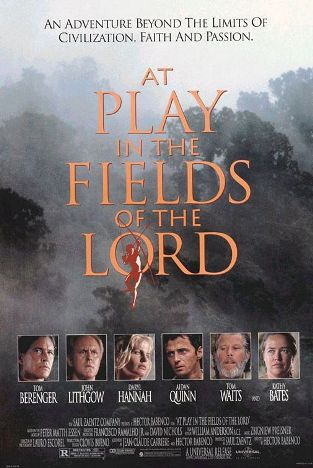- At Play in the Fields of the Lord
Infobox Film
name = At Play in the Fields of the Lord

image_size =
caption = Theatrical poster
director =Hector Babenco
producer = Executive Producer:
David Nichols
Producer:Saul Zaentz
writer = Hector Babenco
Jean-Claude CarrièreVincent Patrick
Story:Peter Matthiessen
narrator =
starring =Tom Berenger Aidan Quinn Kathy Bates Daryl Hannah John Lithgow Tom Waits
music =Zbigniew Preisner
cinematography = Lauro Escorel
editing = William M. Anderson
Armen Minasian
distributor =Universal Pictures
released =December 6 1991
runtime = 189 minutes
country =United States
language = English
budget =
website =
amg_id = 1:3193
imdb_id = 0101373"At Play in the Fields of the Lord" (1991) is a
drama film directed byHector Babenco adapted from the 1965 novel of the same name by American authorPeter Matthiessen . The screenplay was written by Babenco and Jean-Claude Carrière. It starsTom Berenger ,Aidan Quinn ,Kathy Bates ,Daryl Hannah ,John Lithgow andTom Waits . [imdb title|id=0101373|title=At Play in the Fields of the Lord.]The films tells of Americans Lewis Moon (
Tom Berenger ) and Wolf (Tom Waits ) who, when their plane runs out of gas, are stranded in "Madre de Deus" an outpost in the deepBrazil ian Amazon River basin.Plot
Born-again Christian evangelists (
missionary ) Leslie Huben (John Lithgow ) and his wife Andy Huben (Darryl Hannah ); and Martin Quarier (Aidan Quinn ) and his wife Hazel (Kathy Bates ) want to spread the Christian gospel to the primitive Niaruna indigenous natives. ACatholic priest wants to re-establish a mission to the Niarunas, as the former missionary was killed by them. The local police chief wants the Niarunas to move their village so they won't be killed by gold miners moving into the area and cause trouble for him with the provincial government. Lewis Moon (Tom Berenger ), a half-Native AmericanCheyenne , aligns himself with the Niarunas. From this point forward, both are in trouble.The local police chief cuts a deal with Moon: if he and his fellow mercenary bomb the Niaruna village and drive them away, they will be given gasoline for their airplane and allowed to leave. However, things suddenly change when Moon decides to help the Niaruna in a very different way.
Background
Producer
Saul Zaentz first tried to make this film in 1965. Yet, he discovered thatMGM owned the rights toPeter Matthiessen 's novel.Zaentz kept trying to buy them every time there was a top executive change at MGM until 1989 when the new studio heads Jay Kanter and
Alan Ladd, Jr. decided that MGM would not make the film.Zaentz paid $1.4 million for the rights to the novel. [IMDb. Ibid.]
Filming locations
The picture was filmed inBelém do Pará ,Pará ,Brazil .Cast
*
Tom Berenger as Lewis Moon
*John Lithgow as Leslie Huben
*Daryl Hannah as Andy Huben
*Aidan Quinn as Martin Quarrier
*Tom Waits as Wolf
*Kathy Bates as Hazel Quarrier
* Stênio Garcia as Boronai
* Nelson Xavier as Father Xantes
*José Dumont as Commandante Guzman
* Niilo Kivirinta as Billy QuarrierCritical reception
Vincent Canby , film critic for "The New York Times ," had mixed feelings about the film but did like the acting and the screenplay, and wrote, "At Play in the Fields of the Lord" doesn't play smoothly, but it often plays well...Mr. Lithgow and Miss Hannah, who grows more secure as an actress with every film, are fine in complex roles that are exceptionally well written...Though the film features a spectacular penultimate sequence, it seems not to know how to end. It sort of drifts away, perhaps trying to soften its own well-earned pessimism." [ [http://movies2.nytimes.com/mem/movies/review.html?_r=1&title1=AT%20PLAY%20IN%20THE%20FIELDS%20OF%20THE%20LORD%20(MOVIE)&title2=&reviewer=Vincent%20Canby&pdate=19911206&v_id=&oref=slogin Canby, Vincent] . "The New York Times," film review, "Saving the Savages, but Losing Themselves,"December 6 ,1991 .]Critic
Roger Ebert had read the novel and believed the film is true to its themes. Ebert makes the case that producerSaul Zaentz has a history of producing "unfilmable" source material. In an article that basically reviews the plot, he wrote, "Watching it, we are looking at a morality play about a world in which sincere people create unwitting mischief so that evil people can have their way. The movie essentially argues that all peoples have a right to worship their own gods without interference, but it goes further to observe that if your god lives in the land and the trees, then if we destroy your land, we kill your god. These messages are buried in the very fabric of the film, in the way it was shot, in its use of locations, and we are not told them, we absorb them." [ [http://rogerebert.suntimes.com/apps/pbcs.dll/article?AID=/19911206/REVIEWS/112060301/1023 Ebert, Roger] . "Chicago Sun-Times ," film review, December 6, 1991.]Trivia
*
Max Cavalera of Brazilian Metal BandSepultura got the idea for their Album Roots from this Movie.Awards
Wins
*Los Angeles Film Critics Association Awards : LAFCA Award; Best Music,Zbigniew Preisner ; 1991.Nominations
*Golden Globe : Golden Globe; Best Original Score - Motion Picture, Zbigniew Preisner; 2002.References
External links
*
*
*
Wikimedia Foundation. 2010.
